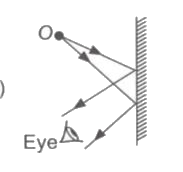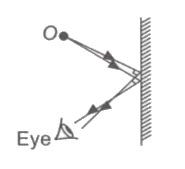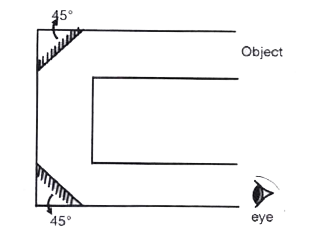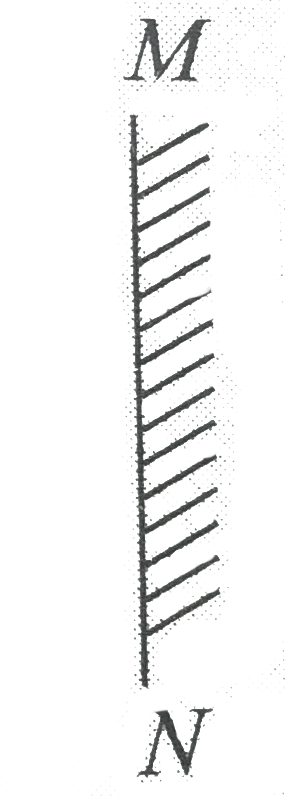A student views an object O by reflection in a plane mirror. Which is the correct ray diagram ?




The correct Answer is:A
To determine the correct ray diagram for a student viewing an object O by reflection in a plane mirror, we can follow these steps:
Step 1: Understand the Laws of Reflection
The laws of reflection state that:
1. The incident ray, the reflected ray, and the normal (a line perpendicular to the surface at the point of incidence) all lie in the same plane.
2. The angle of incidence (the angle between the incident ray and the normal) is equal to the angle of reflection (the angle between the reflected ray and the normal).
Step 2: Draw the Plane Mirror
Start by drawing a straight vertical line to represent the plane mirror.
Step 3: Identify the Object O
Place the object O (which the student is viewing) in front of the mirror. This object can be represented as an arrow or any shape.
Step 4: Draw the Incident Ray
From the top of the object O, draw a straight line towards the mirror. This line represents the incident ray. Make sure to label the angle between this ray and the normal line as the angle of incidence (i).
Step 5: Draw the Normal Line
At the point where the incident ray meets the mirror, draw a dashed line perpendicular to the mirror. This is the normal line.
Step 6: Draw the Reflected Ray
From the point where the incident ray meets the mirror, draw another straight line that reflects off the mirror. This line represents the reflected ray. Make sure to label the angle between this ray and the normal line as the angle of reflection (r).
Step 7: Ensure Angles are Equal
Check that the angle of incidence (i) is equal to the angle of reflection (r). This verifies that the laws of reflection are being followed.
Step 8: Indicate the Image
Finally, indicate the position of the image of object O in the mirror. The image will appear to be behind the mirror at the same distance as the object is in front of it.
Summary of the Diagram
The final ray diagram should show:
- The object O in front of the mirror.
- The incident ray approaching the mirror.
- The normal line at the point of incidence.
- The reflected ray leaving the mirror.
- The angles of incidence and reflection marked and equal.
---
The laws of reflection state that:
1. The incident ray, the reflected ray, and the normal (a line perpendicular to the surface at the point of incidence) all lie in the same plane.
2. The angle of incidence (the angle between the incident ray and the normal) is equal to the angle of reflection (the angle between the reflected ray and the normal).
Start by drawing a straight vertical line to represent the plane mirror.
Place the object O (which the student is viewing) in front of the mirror. This object can be represented as an arrow or any shape.
From the top of the object O, draw a straight line towards the mirror. This line represents the incident ray. Make sure to label the angle between this ray and the normal line as the angle of incidence (i).
At the point where the incident ray meets the mirror, draw a dashed line perpendicular to the mirror. This is the normal line.
From the point where the incident ray meets the mirror, draw another straight line that reflects off the mirror. This line represents the reflected ray. Make sure to label the angle between this ray and the normal line as the angle of reflection (r).
Check that the angle of incidence (i) is equal to the angle of reflection (r). This verifies that the laws of reflection are being followed.
Finally, indicate the position of the image of object O in the mirror. The image will appear to be behind the mirror at the same distance as the object is in front of it.
The final ray diagram should show:
- The object O in front of the mirror.
- The incident ray approaching the mirror.
- The normal line at the point of incidence.
- The reflected ray leaving the mirror.
- The angles of incidence and reflection marked and equal.
Topper's Solved these Questions
- BOOK - SCIENCE OLYMPIAD FOUNDATION CHAPTER - LIGHT, SHADOWS AND REFLECTIONS EXERCISE - ACHIEVERS SECTION (HOTS)5videos
LIGHT, SHADOWS AND REFLECTIONS
- BOOK - SCIENCE OLYMPIAD FOUNDATION CHAPTER - FUN WITH MAGNETS EXERCISE - ACHIEVERS SECTION (HOTS)5videos
FUN WITH MAGNETS
- BOOK - SCIENCE OLYMPIAD FOUNDATION CHAPTER - MOTION AND MEASUREMENT OF DISTANCES EXERCISE - ARCHIEVERS SECTION (HOTS)4videos
MOTION AND MEASUREMENT OF DISTANCES
Similar Questions
(a) To construct a ray diagram, we use two rays which are so chosen that it is easy to know their directions after reflection from the mirror. List two such rays and state the path of these rays after reflection in case of concave mirrors. Use these two rays and draw ray diagram to locate the image of an object placed between pole and focus of a concave mirror.
(b) A concave mirror produces three times magnified image on a screen. If the object is placed 20 cm in front of the mirror, how far is the screen from the object?View SolutionExplain reflection of light at a plane surface with the help of a neat ray diagram.
View Solution
Knowledge Check
- Question 1 - Select One
The angle of deviation of a light ray reflected by a plane mirror is 150∘. The angle of reflection is _____.
A30∘B60∘C15∘D10∘ - Question 2 - Select One
A ray of light is incident at an angle of 35∘ on a plane mirror. What is the angle between the incident and the reflected rays ?
A90∘B100∘C110∘Dnone of these - Question 3 - Select One
The angle of deviation of a light ray reflected by a plane mirror is 150∘. The angle of reflection is _____.
A30∘B60∘C15∘D10∘
A student has constructed a reflecting periscope by arranging two plane mirrors as shown in the figure. What is the nature of the image of an object viewed through this periscope?
 View Solution
View SolutionWhen a light ray is incident normally on the surface of a plane mirror, the reflected ray deviates through an angle of ________
View SolutionA light ray incident on a plane mirror gets reflected from it. Another plane mirror is placed such that the reflected ray from the first mirror is incident on it If the reflected ray from the second mirror travels perpendicular to the indecent ray on the first mirror, determine the angle between two plane mirrors.
View SolutionFigure. Shows a point object A and a plane mirror MN. Find the position of the image of object A, in mirror MN, by drawing ray diagram. Indicate the region in which the observer's eye must be present in order to view the image. (This region is called field of view.)
 View Solution
View Solutionrays of light strike a horizontal plane mirror at an angle of 45∘. At what angle should be a second plane mirror be placed in order that the reflected ray finally be reflected horizontally from the second mirror.
View Solution

